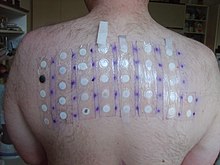Controversy

During the 20th century, the popularity of cosmetics increased rapidly. Cosmetics are used by girls at increasingly young ages, especially in the United States. Because of the fast-decreasing age of makeup users, many companies, from high-street brands like Rimmel to higher-end products like Estee Lauder, cater to this expanding market by introducing flavored lipsticks and glosses, cosmetics packaged in glittery and sparkly packaging, and marketing and advertising using young models. The social consequences of younger and younger cosmetics use has had much attention in the media over the last few years.
Criticism of cosmetics has come from a wide variety of sources including some feminists, religious groups, animal rights activists, authors, and public interest groups. It has also faced criticism from men, some of whom describe it as a form of deception or fakeup.
Safetyedit
In the United States: "Under the law, cosmetic products and ingredients do not need FDA premarket approval." The EU and other regulatory agencies around the world have more stringent regulations. The FDA does not have to approve or review cosmetics, or what goes in them, before they are sold to the consumers. The FDA only regulates against some colors that can be used in the cosmetics and hair dyes. The cosmetic companies do not have to report any injuries from the products; they also only have voluntary recalls of products.
There has been a marketing trend towards the sale of cosmetics lacking controversial ingredients, especially those derived from petroleum, sodium lauryl sulfate (SLS), and parabens.
Formaldehyde is no longer used in cosmetics but has been replaced by formaldehyde releasers. Formaldehyde is dangerous to human health. In 2011, the US National Toxicology Program described formaldehyde as "known to be a human carcinogen".
The danger of formaldehyde is a major reason for the development of formaldehyde releasers which release formaldehyde slowly at lower levels.
Numerous reports have raised concern over the safety of a few surfactants, including 2-butoxyethanol. In some individuals, SLS may cause a number of skin problems, including dermatitis. Additionally, some individuals have had an emergence of vitiliago after using cosmetics containing the ingredient rhododendrol.
Parabens can cause skin irritation and contact dermatitis in individuals with paraben allergies, a small percentage of the general population. Animal experiments have shown that parabens have a weak estrogenic activity, acting as xenoestrogens.
Perfumes are widely used in consumer products. Studies concluded from patch testing show fragrances contain some ingredients which may cause allergic reactions.
Balsam of Peru was the main recommended marker for perfume allergy before 1977, which is still advised. The presence of Balsam of Peru in a cosmetic will be denoted by the INCI term Myroxylon pereirae. In some instances, Balsam of Peru is listed on the ingredient label of a product by one of its various names, but it may not be required to be listed by its name by mandatory labeling conventions (in fragrances, for example, it may simply be covered by an ingredient listing of "fragrance").
Some cosmetics companies have made pseudo-scientific claims about their products which are misleading or unsupported by scientific evidence.
Animal testingedit
This section needs to be updated. (September 2016) |
As of 2009, more than 25 million animals in the United States are used in some type of cosmetic testing. Such tests have involved general toxicity, eye and skin irritants, phototoxicity (toxicity triggered by ultraviolet light), and mutagenicity. Due to the ethical concerns around animal testing, some nations have legislated against animal testing for cosmetics. According to the Humane Society of the United States, there are nearly 50 non-animal tests that have been validated for use, with many more in development, that may replace animal testing and are potentially more efficacious. In the United States, mice, rats, rabbits, and cats are the most used animals for testing. In 2018, California banned the sale of animal tested cosmetics.
Cosmetics testing is banned in the Netherlands, India, Norway, Israel, New Zealand, Belgium, and the UK, and in 2002, the European Union agreed to phase in a near-total ban on the sale of animal-tested cosmetics throughout the EU from 2009, and to ban all cosmetics-related animal testing. In December 2009, the European Parliament and Council passed the EC Regulation 1223/2009 on cosmetics, a bill to regulate the cosmetic industry in the EU. EC Regulation 1223/2009 took effect on July 11, 2013. In March 2013, the EU banned the import and sale of cosmetics containing ingredients tested on animals. China required animal testing on cosmetic products until 2014, when they waived animal testing requirements for domestically produced products. In 2019, China approved nine non-animal testing methods, and announced that by 2020 laws making animal testing compulsory would be lifted.
In June 2017, legislation was proposed in Australia to end animal testing in the cosmetics industry. In March 2019, the Australian Senate passed a bill banning the use of data from animal testing in the cosmetic industry after July 1, 2020.
Comments
Post a Comment